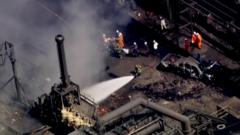Lahore, Pakistan’s second-largest city with a population of 13 million, is grappling with an unprecedented air quality crisis, as recorded air pollution levels soar to alarming heights. Following the city’s worst air quality measures to date, local authorities have taken drastic steps, including shutting down primary and secondary schools, to mitigate health risks, with hundreds hospitalized due to the toxic haze.
The thick, debilitating smog has consistently ranked Lahore as one of the most polluted cities globally, according to IQAir, a Swiss air quality monitoring organization. Reports reveal that on a recent Thursday, Lahore suffered from the worst air quality worldwide, triggering widespread concern among residents and prompt action from government officials.
"Breathing is exhausting, and even with doors and windows closed, the outside air infiltrates our homes," lamented Safdar Masih, a local gardener, expressing the distress faced by many. The city is currently plagued by an oppressive layer of smog that leads to severe health issues, primarily affecting respiratory functions.
In light of the deteriorating air quality, the Punjab provincial government has instructed residents to don masks in public and have mandated that half of the workforce remain home to avoid outdoor exposure. Senior government minister Marriyum Aurangzeb emphasized the severity of the situation, indicating that these poor air conditions could persist for an additional week or more.
In response to public outcry and health risks, authorities are impounding vehicles contributing to pollution, dismantling brick kilns, and enforcing bans on rickshaws, while also shuttering several barbecue restaurants producing excessive smoke. These emergency measures are intended to protect over 70 million residents in Punjab, a province that continues to struggle under the weight of serious environmental challenges.
As citizens and local advocates call for immediate relief and long-term strategies to combat air pollution, the urgency of the situation reflects a growing need for systemic changes to ensure clean air access for all.
The thick, debilitating smog has consistently ranked Lahore as one of the most polluted cities globally, according to IQAir, a Swiss air quality monitoring organization. Reports reveal that on a recent Thursday, Lahore suffered from the worst air quality worldwide, triggering widespread concern among residents and prompt action from government officials.
"Breathing is exhausting, and even with doors and windows closed, the outside air infiltrates our homes," lamented Safdar Masih, a local gardener, expressing the distress faced by many. The city is currently plagued by an oppressive layer of smog that leads to severe health issues, primarily affecting respiratory functions.
In light of the deteriorating air quality, the Punjab provincial government has instructed residents to don masks in public and have mandated that half of the workforce remain home to avoid outdoor exposure. Senior government minister Marriyum Aurangzeb emphasized the severity of the situation, indicating that these poor air conditions could persist for an additional week or more.
In response to public outcry and health risks, authorities are impounding vehicles contributing to pollution, dismantling brick kilns, and enforcing bans on rickshaws, while also shuttering several barbecue restaurants producing excessive smoke. These emergency measures are intended to protect over 70 million residents in Punjab, a province that continues to struggle under the weight of serious environmental challenges.
As citizens and local advocates call for immediate relief and long-term strategies to combat air pollution, the urgency of the situation reflects a growing need for systemic changes to ensure clean air access for all.






















